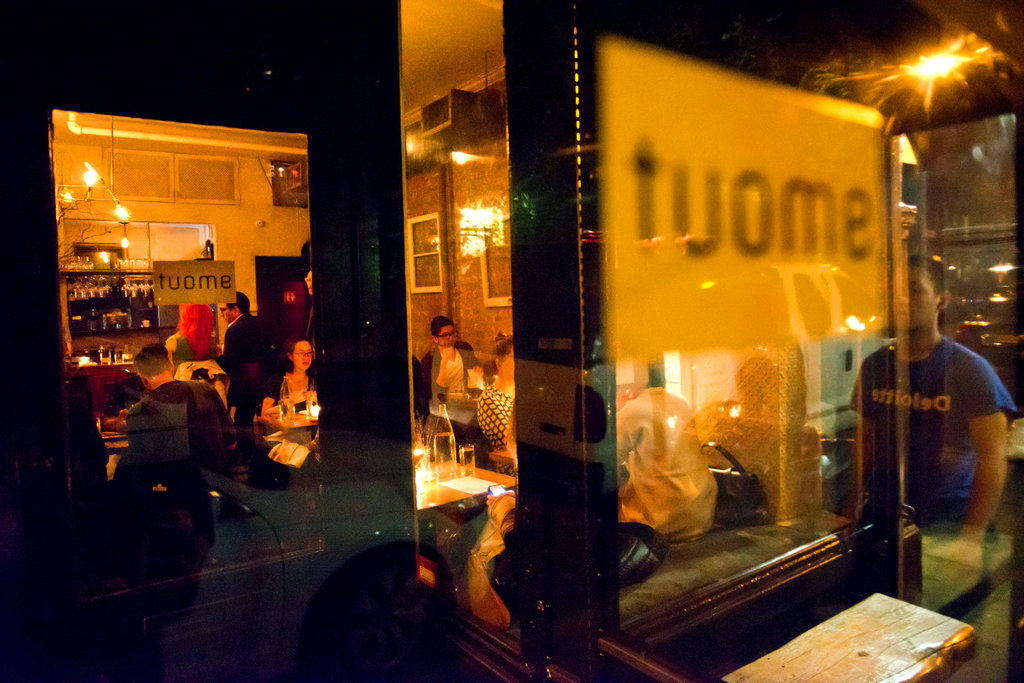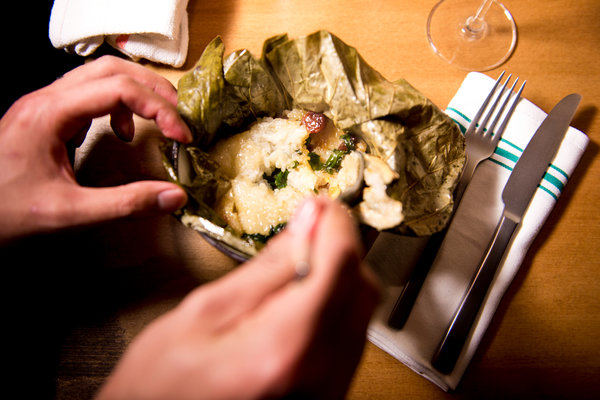
Tuome
CreditLiz Barclay for The New York Times
Look inside the head of a bright young chef and you’ll see a beehive of swarming ideas, a few of them just hatched and others that buzzed in from somewhere else. It can take time to sort out which are borrowed and which have the sting of the new.
Thomas Chen, fresh from the trenches at Eleven Madison Park and Commerce, opened his first restaurant in August, called Tuome. Like so many other places in the era of Noma, it is tastefully spartan in appearance. Its two small dining rooms are furnished with small tables set with small menus printed in small type. The wood chairs and metal bar stools are unsoftened by fabric or cushions. The lights are dim — not flattering, first-date dim but I’m-too-young-to-be-going-blind dim. In terms of glitz and glamour, Tuome falls somewhere between a yoga studio and Thoreau’s cabin.
I’ve eaten in plenty of rooms like this over the last few years. And I’ve seen any number of dishes resembling these: the Nike swooshes of ultra-blended vegetable purées; the green leaves the size of chipmunk ears arranged just so over a deviled egg; the row of scallops all crouched together as if hiding from some scallop-hating predator on the other side of the plate. Clearly Mr. Chen and I have been following the same Instagram feeds.

That egg, though. Wait a minute. This is something different.
There is half of a hard-cooked white, deep-fried in panko. Spooned into the divot is a dot of deviled yolk, sharp with pickles and Dijon mustard. On top of that is a spoonful of fried garlic and dried chiles in their spicy red oil. It’s fun to feel the temperatures and textures, creamy and crackling and slippery, meet in your mouth, and to taste the strange collision of church-picnic-style eggs with a Chinese condiment. How can half an egg do three or four things at once?
Later, a server points a siphon into the crook of an octopus leg. Out comes a suede-colored snowdrift. He says it’s brown-butter-and-potato espuma. I say it’s foam and I say the hell with it. I focus on the octopus, which crunches emphatically and has a rounded, slightly fruity flavor. With it is a chewy, chunky, lightly gingered XO sauce. Chopped caramelized pork and Chinese sausage give it the sweetness of bacon; fish sauce and dried shrimp take it broader and deeper. I can’t get enough of it. The foam will not be ignored forever, though. While it is not the most original notion, it does add something, unlike most foams. What it adds is a fluffy wave of toasted butter, like the frosting on a caramel cake minus the sugar and the heft. The dish is peculiarly good; it makes an extraordinary indulgence out of the octopus. And it shows off the clear and fresh point of view Mr. Chen brings to his cooking, particularly when he interprets Chinese flavors.
Cooking Newsletter
New recipes from The New York Times, delivered to your inbox three times a week.
Before working at Eleven Madison Park and Commerce, Mr. Chen was an accountant. The idea was to stay as far from restaurants as possible, and it came from his parents. After moving from China to New York City, the Chens operated a Chinese restaurant outside of the city. They wanted something higher for Thomas (he was Tommy at home, but on his parents’ lips the nickname came out “tow me,” which is how Tuome is pronounced), but after shepherding balance sheets by day and attending culinary school by night, he came to see cooking as the higher calling.
A little more than two months in, Tuome is already starting to feel mature. The one-page wine list is seriously eclectic, but it’s not too cool for a Napa Valley cabernet and an Anderson Valley chardonnay. The servers take their jobs seriously, although I’m not sure the point has to be underlined by forcing them all to wear tailored T-shirts the color of wet cement. Mr. Chen doesn’t need to make his staff look like a modern dance troupe to tell people Tuome isn’t your average East Village spot; his cooking does that for him. (And the East Village average is getting higher every year.)
He has terrific control over salt, spices, texture and contrast, weaving them together until you ask, why hasn’t anyone done this before? Adding slick duck fat to packets of Cantonese sticky rice steamed in lotus leaves seems like an obvious good idea. So does the extra crackle he puts into the Chinese sausage bits to save the rice from gummy monotony. But they aren’t obvious until you taste Mr. Chen’s version.

A few dishes show off Mr. Chen’s technical command more than his originality. The scoop of chicken liver mousse with maple syrup pooled in a hollow on top, like the gravy on mashed potatoes, is exquisitely done, but feels familiar. Another dish fell out of focus between meals, when the carrot-miso purée accompanying seared scallops lost its savory, salty depth and became merely sweet. And there’s one I’d like to forget, a dully sweet squash soup impaled with frogs’ legs that were both mushy and stringy.
But a striking number of dishes at Tuome are memorable for the right reasons. Serving sous-vide chicken on soupy rice cooked with garlic chives and shiitakes, Mr. Chen doesn’t try to sex up his homey inspiration, congee; he just makes it more layered and modern, surrounding the chicken with a dark basil jus, and lets the flavors quietly win you over.
I wish he would take the same approach with pork belly instead of forcing it to do double-duty as a marketing event. Right now it’s called the Pig Out (a name meant for hashtagging), and it marches to the table as a $49 feast for two, 10 bite-size squares of pork belly riding on a slate shingle with a parade of sauces and bowls of spicy-peanut noodles following behind. The crashing cymbals can’t disguise how easily the dish, and its price, could be divided in half.
But Mr. Chen has done something amazing to this pig. His inspiration may have been Cantonese roast pork, but these compressed, intensely flavorful squares of well-rendered belly partake of Peking duck, too. After I’d topped the reflective pane of skin with ginger-scallion sauce and a few drops of sambal from a squeeze bottle, I wanted to tuck the pork into a steamed bun or a crepe, and then chew and crunch and chew and crunch some more. Forget the gimmick. There are fresh ideas in this dish, and they are all Mr. Chen’s.